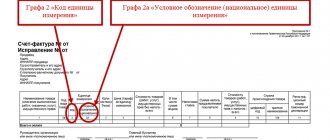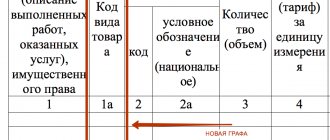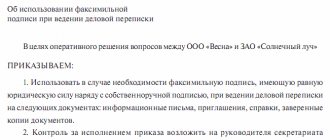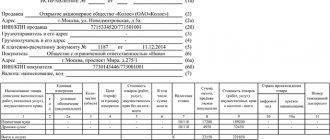Rules for working with invoices: basics
An invoice is a document that serves as a documentary basis for the buyer to accept the VAT amounts presented by the seller for deduction (reimbursement) (Clause 1 of Article 169 of the Tax Code of the Russian Federation). An invoice must be issued every time you sell goods, work, services or property rights. Invoices can be issued on paper or electronically.
From October 1, 2021, a new invoice form will apply. See “New invoice form from 10/01/2017: form and sample filling“.
The paper form of the invoice and the rules for filling it out are approved in Appendix 1 to the Decree of the Government of the Russian Federation of December 26, 2011 No. 1137.
Decree of the Government of the Russian Federation dated December 26, 2011 No. 1137 approved the current forms and Rules for filling out (maintaining) the following documents used in VAT calculations:
- invoices (Appendix No. 1);
- adjustment invoice (Appendix No. 2);
- log of received and issued invoices (Appendix No. 3);
- purchase books (Appendix No. 4);
- sales books (Appendix No. 5).
If the seller wishes to send invoices to buyers electronically, the buyer must agree to this. At the same time, the means of receiving, exchanging and processing invoices electronically between the seller and the buyer must be compatible. They must comply with the established formats (paragraph 2, paragraph 1, article 169 of the Tax Code of the Russian Federation). Invoices are issued and received electronically in the manner approved by Order of the Ministry of Finance of Russia dated November 10, 2015 No. 174n.
Why are adjustment invoices needed?
The Tax Code of the Russian Federation establishes the obligation to issue adjustment invoices (paragraph 3, clause 3, article 168 of the Tax Code of the Russian Federation). Sellers of goods (work, services) issue such invoices in the event of an adjustment to the cost of goods shipped (work performed, services rendered) or transferred property rights. This can happen when, for example, prices or quantity (volume) of goods (work, services), property rights change.
Adjustment invoice
Changes in the form of an adjustment invoice repeat changes in the form of the main invoice. Firstly , column 1b has been added to the adjustment account form. It indicates the product type code. We fill out this column if the organization exports goods to the countries of the EAEU (Eurasian Economic Union).
Secondly , from October 1, 2021, it is allowed to add additional lines and columns to the adjustment invoice (for example, details of the primary invoice). In this case, the form of the adjustment document itself should not change.
Mandatory invoice details
Let us list an exhaustive list of details that must be filled out in invoices (clauses 5 and 6 of Article 169 of the Tax Code of the Russian Federation):
- serial number and date of compilation;
- name, address and identification numbers of the seller and buyer or contractor and customer;
- name and address of the shipper and consignee - only for shipped goods;
- number of the payment order or other payment and settlement document - if payment took place before shipment;
- the name of the goods shipped or a description of the work performed, services provided and property rights transferred, their units of measurement, when they can be determined;
- the quantity of goods shipped or the volume of work performed and services provided in the specified units of measurement, when they can be determined;
- name of currency;
- price per unit of measurement, if possible, under the contract excluding tax. In case of application of state regulated prices - taking into account the amount of tax;
- the cost of goods shipped, work performed, services provided, transferred property rights without tax;
- the amount of excise duty on excisable goods;
- tax rate;
- the amount of tax based on current tax rates;
- the cost of the total quantity of goods supplied (shipped) according to the invoice (work performed, services rendered), transferred property rights, taking into account the amount of tax;
- country of origin of the goods - only for imported goods;
- customs declaration number - only for imported goods;
- code of the type of goods according to the Commodity Nomenclature of Foreign Economic Activity of the EAEU - when exporting goods to the countries of the Eurasian Economic Union.
Here's what an invoice form looks like in 2021:
You can submit an invoice valid until June 30, 2017.
From July 1, 2021, the invoice has been supplemented with a new line
By Decree of the Government of the Russian Federation dated May 25, 2017 No. 625, changes were made to the invoice and adjustment invoice forms. The amendments provide that from July 1, 2021, the invoice form is supplemented with line 8 “Identifier of the state contract, agreement (agreement).” The adjustment invoice, in turn, from July 1, 2021 is supplemented with a new line 5 with the same name.
Starting from July 1, 2021, the new line will require the identification of the state contract for the supply of goods (performance of work, provision of services), contract (agreement) on the provision of subsidies from the federal budget to a legal entity, budget investments, contributions to the authorized capital.
It was necessary to make changes to the invoice form due to the entry into force of Federal Law No. 56-FZ dated 04/03/2017, which expanded the scope of information that must be indicated in the invoice issued for the sale of goods (work, services), transfer of property right
Here is a sample of the new invoice effective July 1, 2021 in Excel format.
You can also create a new form for an adjustment invoice, valid from July 1, in Excel format.
Conclusion
From July 1, 2021, when selling goods (work, services) under government orders, suppliers will be required to indicate the identifier of the government contract, agreement (agreement) in invoices. New requirements are established by Federal Law dated April 3, 2017 No. 56-FZ. However, the forms of the invoice and adjustment invoice have not changed. They will still need to be exhibited in the forms established by Decree of the Government of the Russian Federation of December 26, 2011 No. 1137.
How to set up the reflection of the government contract ID in invoices in 1C
Regulatory regulation
Decree of the Government of the Russian Federation dated December 26, 2011 No. 1137, which is responsible for the form of the invoice, has been updated (Resolution of the Government of the Russian Federation dated May 25, 2017 N 625). Let's look at the innovations regarding the issuance of paper invoices.
Main change : Added new line 8 “Identifier of government contract, agreement (agreement)” for the invoice (UPD) and similar data is reflected in line 5 of the adjustment invoice. This detail is indicated only if the Organization works under government contracts and such a code is assigned to the contract.
and samples of filling from 07/01/2017:
- Invoice;
- Adjustment invoice;
- Universal transfer document (UDD).
Accounting in 1C
Step. 1. In order for invoices to reflect the identifier of a government contract, in the Main – Settings – Functionality on the Calculations , select the “Invoices for government orders” checkbox (Fig. 1):
Rice. 1
Step. 2 . Open the primary document “Sales (acts, invoices)”, issue an invoice and follow the link to the invoice form to indicate the identifier (Fig. 2):
Rice. 2
Step. 3 . Enter the necessary information in the “Government Contract ID” field in the invoice (Fig. 3):
Rice. 3
The identifier can contain 20 or 25 characters depending on the type of contract (Fig. 4):
Rice. 4
Contracts worth less than RUB 100,000. no identifier is assigned.
The Federal Tax Service has posted a reminder on its portal that the identifier must also be indicated in the advance invoice.
The new analytics “Government Contract Identifier” will now allow fiscal authorities to gain additional control over the use of federal budget funds.
The invoice form from July 1, 2017 has the following form (Fig. 5):
Rice. 5
UPD form recommended for use from July 1, 2017 (Fig. 6):
Rice. 6
Adjustment invoice form (Fig. 7):
Rice. 7
New invoice format from July 1, 2017
From July 1, 2021, it is allowed to generate invoices in electronic form exclusively according to the new format approved by Order of the Federal Tax Service dated March 24, 2016 No. ММВ-7-15/155.
An adjustment invoice from July 1, 2021 can also be submitted only in a new format, which was approved by Order of the Federal Tax Service dated April 13, 2016 No. ММВ-7-15/189.
Please note that the formats of electronic invoices are approved by orders of the Federal Tax Service of Russia dated March 24, 2016 No. MMV-7-15/155 and dated March 4, 2015 No. MMV-7-6/93. Until July 1, 2021, both formats are valid simultaneously. And during the period from May 7, 2021 to June 30, 2021, it is allowed to generate invoices in any format: both old and new. However, from July 1, 2021, the “old” electronic format of invoices cannot be used (clauses 2 and 3 of the order of the Federal Tax Service of Russia dated March 24, 2016 No. ММВ-7-15/155).
What has changed in the format
There are no changes to the invoice metrics, form or data structure in the new format. The reason for the appearance of the new format was the introduced ability to indicate additional information in invoices, including details of the primary document. In fact, the new invoice format has also become the format of a universal transfer document (UD).
Also, the new invoice format from July 1, 2021 may include not one file, as before, but two, which at the same time have multidirectional movement: from seller to buyer and from buyer to seller.
Read also
24.08.2017
How to work with electronic invoices
It is possible to receive or send electronic invoices (ESF) only if all 3 parties (buyer, seller, EDI operator) can simultaneously participate in this, the technical means are in order and there is access to the Internet. The procedure for working with ESF was approved by Order of the Ministry of Finance No. 174n.
In this case, the seller needs to generate, sign and send the ESF, then wait for notification from the buyer of its receipt. After receiving the ESF, the buyer is required not only to issue this notice, but also to confirm receipt of the ESF to the operator. The operator has a special function: he ensures the delivery of the ESF, organizes verification of compliance with established formats and records the dates of its sending and receipt.
IMPORTANT! The ESF is drawn up in only one (!) copy, and only one authorized person can sign it (clause 6 of Article 169 of the Tax Code).
Is it possible, after preparing a paper invoice for the buyer, to make an electronic copy for yourself? In September 2021, the Federal Tax Service of the Russian Federation, having coordinated its position with the Ministry of Finance of the Russian Federation, gave a positive answer. Let us note that the Ministry of Finance previously spoke negatively on this issue.
Important to consider! Recommendation from ConsultantPlus: Store electronic invoices in electronic form. There is no need to print them out on paper (Letter of the Federal Tax Service of Russia dated July 19, 2017 No. SD-4-3/ [email protected] ). Along with electronic invoices, you must store documents and information...(see K+ for more details).











